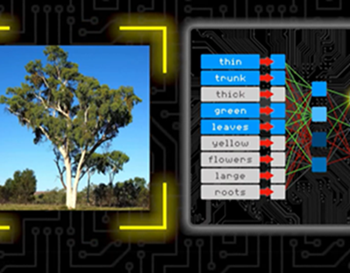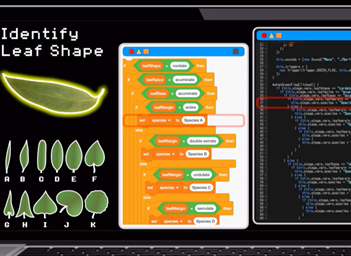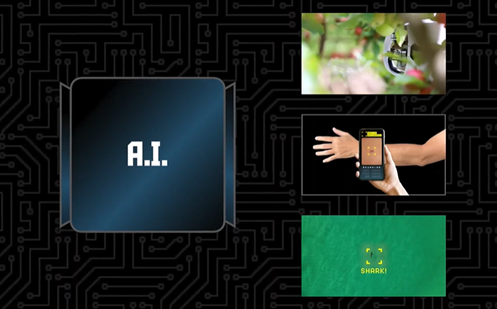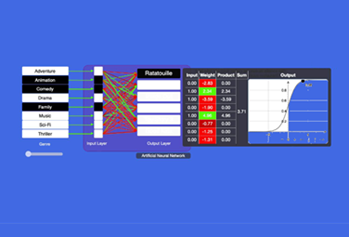AI course for teachers of DT
Our AI course, consisting of 7 modules is designed to provide an introduction to artificial intelligence and how it can be used for an authentic context for learning. We use practical examples to explore machine learning and data bias. For those interested in connecting AI and programming we offer a module for primary teachers and another that is secondary-focused. We explore responsible AI and the impact of AI systems on society and the process of design, focusing on designing AI-driven solutions that benefit the user and society. And if you are interested in the inner workings of an AI we delve into artificial neural networks (ANNs).
Each self-paced module is expected to take less than 1 hour, is free and requires no log-in.

Artificial intelligence: What’s it about?
Artificial intelligence (AI) is a transformative technology that is getting significant media attention. On the one hand, we are hearing about the latest developments and the positive impact they will have on society. On the other hand, we are hearing about the challenges, issues and potential risks associated with AI.
In this module, we explore these aspects to give teachers a solid foundation to taking the first steps in AI with their students.
As a result of completing this module, participants will be able to:
- describe ways AI is used in everyday life
- identify ways AI can be used as an authentic context for learning
- explain benefits and challenges associated with AI technologies
- recognise the difference between Generative and non-Generative AI tools
- become familiar with some non-Generative AI tools
- describe some important considerations when implementing AI as part of student learning.
How does an AI learn?
Machine learning is a term associated with artificial intelligence (AI). You may have some familiarity with what it means and an understanding that it relates to how a machine learns to carry out human-like tasks.
This module explores machine learning using practical examples that you can use with your students. The student becomes the teacher (supervised learning) and trains an AI using input data such as image data they have selected. The module also explores how bias can creep in and what constitutes a robust dataset.
As a result of completing this module, participants will be able to:
- explain how an AI can be trained to recognise images
- use practical examples to explain machine learning
- explain how bias applies to AI systems
- describe curriculum connections using AI image recognition as a context.


AI and conventional programming (Primary)
This module explores the differences between AI and conventional programming, and uses AI systems as an authentic context for students to learn and develop visual programming skills.
As a result of completing this module, participants will be able to:
- describe differences between AI and conventional programming
- describe ways to use AI systems as an authentic context for students to learn and develop visual programming skills
- develop understandings about relevant programming skills for Years 3–6
- become familiar with the process to incorporate an AI model into a visual program
- describe curriculum connections using AI as a relevant context
- describe and implement approaches to assess student programming projects.
AI and conventional programming (Secondary)
This module delves into coding using artificial intelligence (AI) libraries in both JavaScript and Python. We start our journey with JavaScript, leveraging Google's Teachable Machine, to craft a gesture recognition system for the classic game of 'Rock, Paper, Scissors'.
Then we transition away from Teachable Machine and immerse ourselves in the world of Python with the Scikit library (a Python library to implement machine learning models and statistical modelling). Here, we develop a classification framework to train the AI to recognise pixel-based graphics.
As a result of completing this module, participants will be able to:
- describe the differences between AI and conventional programming
- describe ways to use AI systems as an authentic context for students to learn and develop general-purpose programming skills
- develop an understanding of relevant programming skills for Years 7–10
- become familiar with the process of incorporating an AI model into a general-purpose program
- describe curriculum connections using AI as a relevant context
- describe and implement approaches to assess student programming projects.


Responsible AI
Responsible AI is an approach to AI development and deployment that aims to harness the benefits of AI while minimising potential harms and risks.
In this module, we explore the impact of AI systems on society. As we explore the benefits that AI will bring, we also raise and consider the challenges it poses, and apply our ethical understandings when confronted with ethical dilemmas.
After completing this module, participants will be able to:
- identify values and ethical concepts that can be investigated through evaluating AI-driven solutions
- investigate AI-driven solutions applying ethical understanding
- explore ethical dilemmas with your students using a relevant pedagogical approach
- identify curriculum connections when evaluating AI-driven solutions.
Designing an AI-driven solution
The role of design in AI solutions is essential, as it shapes the user experience, usability and overall effectiveness of these technologies. Design not only enhances aesthetics but ensures that AI solutions are intuitive, accessible, aligned with user needs and, importantly, based on ethical principles.
This module explores the process of design, focusing on designing AI-driven solutions that benefit the user and society.
As a result of completing this module, participants will be able to:
- describe the steps of the user-centred design process
- apply the user-centred design process to create an AI-driven solution
- describe ways to incorporate user stories in the design process
- describe curriculum connections when designing an AI-driven solution.


Inner workings of an AI
This module explores the inner workings of one of the most popular machine learning technologies: artificial neural networks (ANNs).
As a result of completing this module, participants will be able to:
- describe how ANNs are made from artificial neurons that are organised in layers
- describe that deep learning refers to the large number of hidden layers in ANNs
- describe how the ANN learning process adjusts the network weights
- trace a simple spreadsheet ANN
- explain the mathematics behind an ANN, consisting of products, sums and functions
- apply the learning to a variety of ANN models and applications.